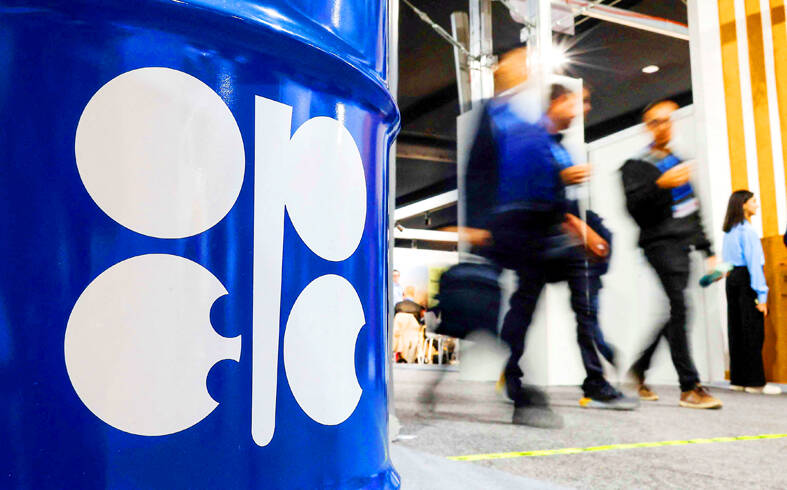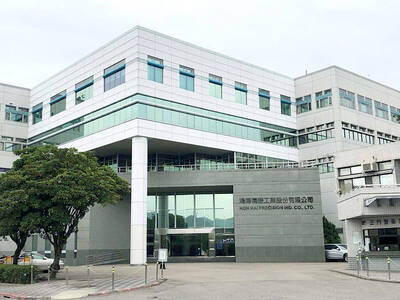OPEC+ agreed in principle to boost oil output by 548,000 barrels per day next month, two OPEC+ sources said yesterday as the group finishes unwinding its biggest tranche of production cuts amid fears of further supply disruptions from Russia.
A decision is expected at a meeting scheduled to begin at 6pm, amid fresh US demands for India to stop buying Russian oil as Washington seeks ways to push Moscow for a peace deal with Ukraine. Fresh EU sanctions have also pushed Indian state refiners to suspend Russian oil purchases.
OPEC+, which pumps about half of the world’s oil, had been curtailing production for several years to support the market, but it reversed course this year to regain market share, and as US President Donald Trump demanded OPEC pump more oil.

Photo: Reuters
OPEC+ began output increases in April with a modest hike of 138,000 barrels per day, followed by larger hikes of 411,000 barrels per day in May, June and last month, and 548,000 barrels per day this month.
If the group agrees to the 548,000-barrels-per-day increase next month, it would have fully unwound its previous production cut of 2.2 million barrels per day, while allowing the United Arab Emirates to raise output by 300,000 barrels per day.
OPEC+ still has in place a separate, voluntary cut of about 1.65 million barrels per day from eight members and a 2 million-barrels-per-day cut across all members, which expires at the end of next year.
Sources have said previously that the group had no plans to discuss other tranches of cuts.

Shares in Taiwan closed at a new high yesterday, the first trading day of the new year, as contract chipmaker Taiwan Semiconductor Manufacturing Co (TSMC, 台積電) continued to break records amid an artificial intelligence (AI) boom, dealers said. The TAIEX closed up 386.21 points, or 1.33 percent, at 29,349.81, with turnover totaling NT$648.844 billion (US$20.65 billion). “Judging from a stronger Taiwan dollar against the US dollar, I think foreign institutional investors returned from the holidays and brought funds into the local market,” Concord Securities Co (康和證券) analyst Kerry Huang (黃志祺) said. “Foreign investors just rebuilt their positions with TSMC as their top target,

REVENUE PERFORMANCE: Cloud and network products, and electronic components saw strong increases, while smart consumer electronics and computing products fell Hon Hai Precision Industry Co (鴻海精密) yesterday posted 26.51 percent quarterly growth in revenue for last quarter to NT$2.6 trillion (US$82.44 billion), the strongest on record for the period and above expectations, but the company forecast a slight revenue dip this quarter due to seasonal factors. On an annual basis, revenue last quarter grew 22.07 percent, the company said. Analysts on average estimated about NT$2.4 trillion increase. Hon Hai, which assembles servers for Nvidia Corp and iPhones for Apple Inc, is expanding its capacity in the US, adding artificial intelligence (AI) server production in Wisconsin and Texas, where it operates established campuses. This

Nvidia Corp chief executive officer Jensen Huang (黃仁勳) on Monday introduced the company’s latest supercomputer platform, featuring six new chips made by Taiwan Semiconductor Manufacturing Co (TSMC, 台積電), saying that it is now “in full production.” “If Vera Rubin is going to be in time for this year, it must be in production by now, and so, today I can tell you that Vera Rubin is in full production,” Huang said during his keynote speech at CES in Las Vegas. The rollout of six concurrent chips for Vera Rubin — the company’s next-generation artificial intelligence (AI) computing platform — marks a strategic

US President Donald Trump on Friday blocked US photonics firm HieFo Corp’s US$3 million acquisition of assets in New Jersey-based aerospace and defense specialist Emcore Corp, citing national security and China-related concerns. In an order released by the White House, Trump said HieFo was “controlled by a citizen of the People’s Republic of China” and that its 2024 acquisition of Emcore’s businesses led the US president to believe that it might “take action that threatens to impair the national security of the United States.” The order did not name the person or detail Trump’s concerns. “The Transaction is hereby prohibited,”